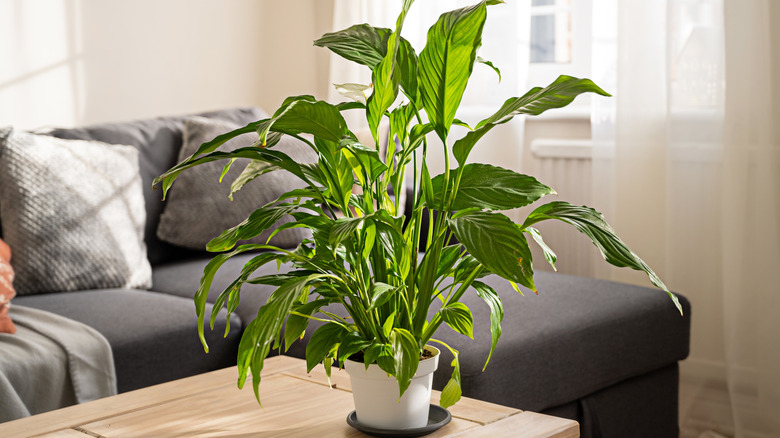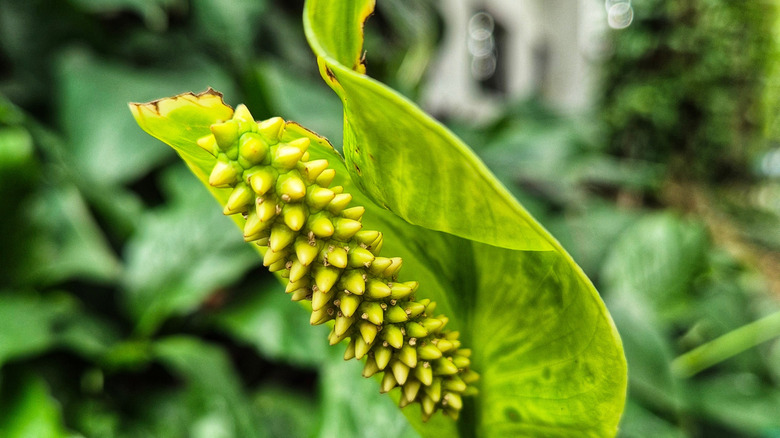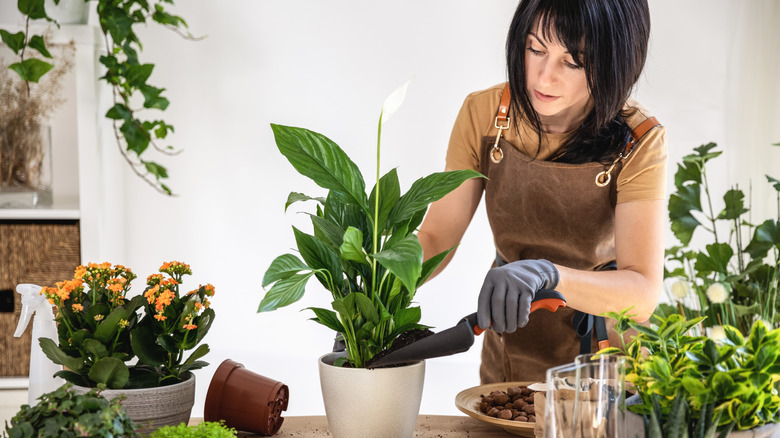Why Beautiful Green Flowers On A Peace Lily Isn't What You Want
If you're beginning to see your white peace lily flowers turn green, and getting worried about the loss of visual contrast in your houseplant as well as its health, your concern is justified. Although most of the time, this change does not severely affect plant health, it is definitely not optimal, and the flowers look a lot less striking when they are not white. Green flowers in peace lilies essentially mean that you have either over-fertilized your plant or not given it the right amount of light.
Peace lilies (Spathiphyllum spp.) are some of the easiest plants to grow for beginners because of their love of moderation. They're are also shade-loving plants that can handle some neglect. Nonetheless, they are still vulnerable to health problems if not well cared for — green flowers being one of them. A complete lack of flowers, on the other hand, is a tell-tale sign your peace lily is in trouble.
Having said all that, technically speaking, the beautiful white "flowers" on your peace lilies are not even actual flowers but modified leaves called spathes. Since peace lilies belong to the Araceae family, which boasts many unique inflorescences, their flowering structure consists of a spathe, or spoon-like leaf, which protects the spadix — the actual cluster of tiny flowers inside. As the plant grows, the spathe is initially greenish, then transforms to a full bright white color, and then goes back to green as the actual flower starts to fade.
External factors that can make a peace lily flower turn green
Overfeeding is one of the primary reasons why peace lily flowers turn green, and you should take this as a warning sign because it could result in further damage to your plant. Being highly prone to root burn, you can severely damage your peace lilies if you overfeed them. Apart from the green color of the spathe, this damage will also be evident from the discoloration of the leaves (which turn brown or black on the tips).
Other environmental factors can also cause the spathes to change color. Being tropical in nature, peace lily varieties like to have at least 40 to 60% humidity in the atmosphere. Its flowers can turn green when this ideal humidity level gets disturbed, showing signs of stress on the plant. Similarly, a shift in temperatures from the ideal 65 to 80 degrees Fahrenheit can also lead to green flowers.
Light also has a major effect on peace lily flowers, and the plant's morphology makes this relation easy to understand. Since peace lily flowers are actually leaves, and the primary function of leaves is photosynthesis, it is only natural that the process gets triggered even more so when the plant receives bright sunlight. Consequently, you witness your beloved white flower gradually turn green because of the chlorophyll in the leaf. Moreover, less than optimum sunlight can also cause the flower to turn green. When peace lilies do not get enough sunlight, the spathe starts producing more chlorophyll to speed up photosynthesis. Keep in mind that the change in the color of the spathe is a natural process that is bound to happen anyway as your peace lily flower ages. However, the amount of light the plant receives can drastically influence this process.
Steps to prevent your peace lily flowers from turning green
The best thing you can do to make sure your peace lily keeps producing white flowers is to keep your fertilizer in check. If you're growing peace lilies as houseplants, make sure you use a balanced 10-10-10 liquid houseplant fertilizer at quarter-strength. When it comes to frequency, feeding these plants once every six or eight weeks during active growth in the warmer months is more than enough. You should also get rid of any excess salt buildup in the soil by flushing it with water every few months. Having said that, once a flower does turn green, reducing the feed will not get it back to white. Nonetheless, you can expect more white flowers the next time the plant blooms.
Furthermore, you can also consider shifting the location of your peace lilies to a place that receives bright but indirect light, like an east-facing window, to prevent the green pigmentation. This will make sure that the amount of sunlight the plant receives does not stimulate photosynthesis in the leaves or cause them to burn. To keep optimum humidity levels for your peace lily, you can consider misting your plant, using a humidifier, or a pebble tray filled with water. Consistent evaporation of water from the tray would create a nice and humid ambiance for the plant, while the pebbles would ensure that the roots do not rot because the base of the pot is not sitting in water. Finally, avoid keeping the plant near heaters, air conditioners, or cold drafts.


